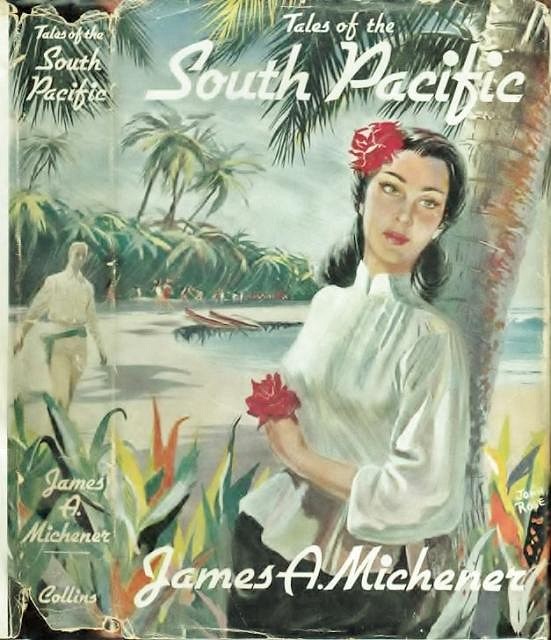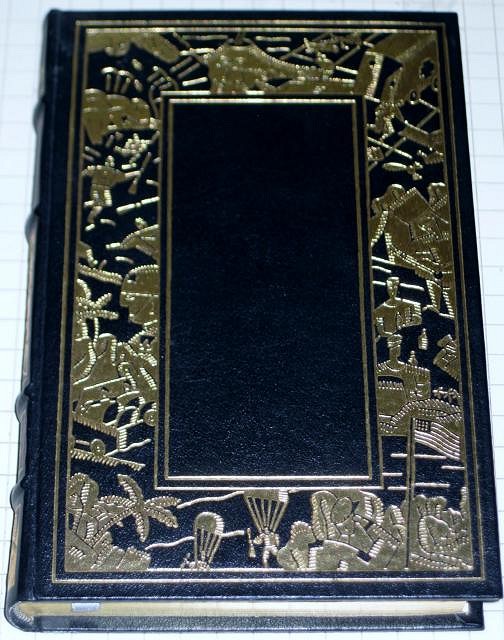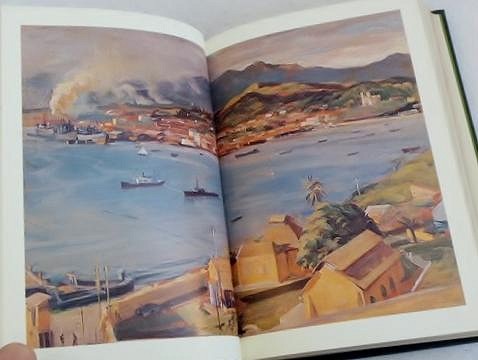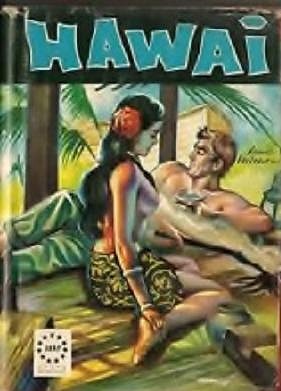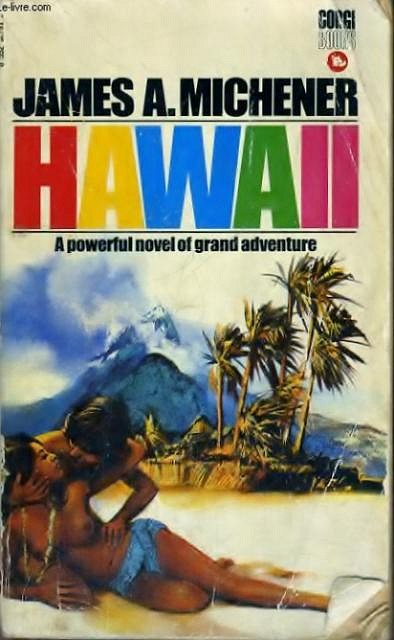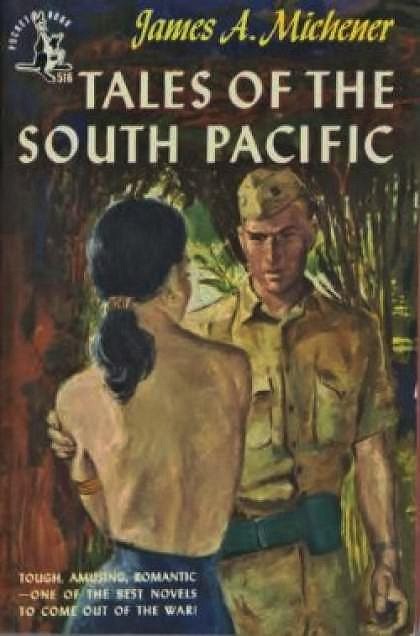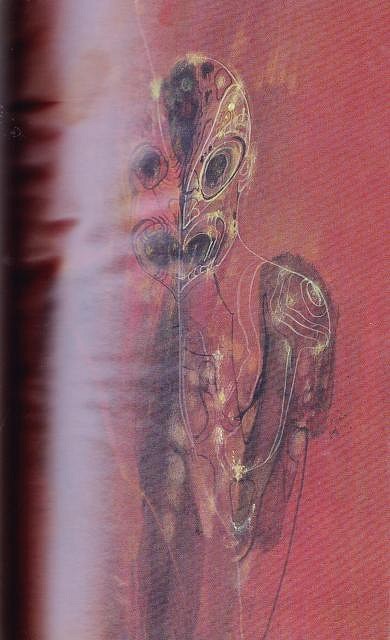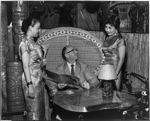Tiki Central / General Tiki
James Michener
Pages: 1 45 replies
|
TW
Trader Woody
Posted
posted
on
Wed, Jul 31, 2002 1:48 AM
Is James Michener the forgotten man of Tiki? It just struck me that Michener I'm no expert, as I've only read Hawaii, a copy of which was kindly given to Anyone more familiar with his works? Does he deserve to be placed with Trader Woody [ Edited by: Trader Woody on 2002-07-31 01:48 ] |
|
K
kongtiki
Posted
posted
on
Wed, Jul 31, 2002 7:47 AM
"Rascals in Paradise" by Michener and A. Grove Day is also a pleasant accounting of white men let loose in the South Pacific...worth a read if you haven't... |
|
K
Kailuageoff
Posted
posted
on
Wed, Jul 31, 2002 11:09 AM
We rented the video "South Pacific" last year and thought it was great, so we bought the DVD. Then I read "Tales of the South Pacific" and, of course, thought it was better than the movie musical. I recommend the book highly because a) it is very well written, B)it contains wonderful descriptions of American GI's and nurses discovering Polynesia in the 1940's, and C) it was a huge best-selling book and helped spark the tiki craze. (See Sven's video for an interview with the author). I have two other books of his called "Return to Paradise" and "Rascal's in Paradise", which I have yet to read. All three books are commonly available in thrift stores and second-hand book shops. |
|
T
thejab
Posted
posted
on
Wed, Jul 31, 2002 2:35 PM
I read Hawaii before I went to the islands and enjoyed it. Michener really did his research before writing a book. It takes a while to read such a long novel but it's worth it. |
|
TC
Tiki Chris
Posted
posted
on
Thu, Aug 1, 2002 2:48 PM
"Hawaii" is an incredible book! I took a long time to read it too, but I think I might have stretched the time b/c I just didn't want the book to end! My wife had a similar experience reading "Iberia" in which Michener accounts his travels in Iberia (duh) during the late 50s (& early 60s?). "Tales from the South Pacific" is brilliant, especially considering it was his first book! I'm sure it had a significant impact/influence on tiki culture. WARNING: BY NO MEANS SHOULD ANY OF YOU EVER WATCH THE FILM ADAPTATION OF "HAWAII" STARRING JULIE ANDREWS!!! It sucks real bad, is nothing like the book, & focuses soley on probably the most miserable part of the 'story of Hawaii' (when the New England missionaries came). Fortunately, I read the book first b/c if I had seen the movie first I probably would have done my damnedest to stay as far away from anything associated w/ Michener (who actually had nothing to do w/ the film adaptation). :sheckymug: [ Edited by: Tiki Chris on 2002-08-01 14:50 ] |
|
TW
Trader Woody
Posted
posted
on
Thu, Aug 1, 2002 3:22 PM
"Hawaii" the soundtrack blows too. Michener & Martin Denny should have been a marriage made in Tiki heaven, but it's oddly forgettable stuff. Trader Woody |
|
B
bigbrotiki
Posted
posted
on
Thu, Aug 1, 2002 7:27 PM
The thing about James Michener I like best is that he was a genuinely NICE GUY, even after he made tons of money. He gave huge chunks of it to charity (BEYOND tax write offs) and kept on working, writing very complex human stories. I swear, I am not turning conservative as I am getting older! I just LIKE those kinda guys. |
|
K
Kilikopela
Posted
posted
on
Thu, Aug 1, 2002 8:08 PM
Hey Tiki Chris, Do you think the movie "Hawaii" is worth watching if, say... you had a fetish for Julie Andrews? Is she in a grass skirt in this movie? Does she sway her hips seductively? Does she.... Uh, I better stop here. |
|
TC
Tiki Chris
Posted
posted
on
Fri, Aug 2, 2002 1:46 AM
I've always considered Ms. Andrews to be a bit of hottie (in a prudish sort of way) but would still advise fellow admirers to steer clear of "Hawaii". Stick w/ one of her classics that's sure to get your blood pumpin' - "Mary Poppins!" Just a Spoon Full of Sugar, [ Edited by: Tiki Chris on 2002-08-02 01:46 ] |
|
S
SlovakTiki
Posted
posted
on
Thu, Nov 7, 2002 8:52 AM
I have just started to read "Tales of the South Pacific" by Michener(thanks to it's mention in the Book by Mr. Kirsten)and it is quite an excellent book.Subsequently I got ahold of a copy of the restored version of the film "Hawaii" from 1966(starring the hottie Julie Andrews and the immensely talented Max von Sydow).I must say that my girlfriend and I enjoyed the film immensely and thought it was a work of high quality. |
|
T
thejab
Posted
posted
on
Thu, Nov 7, 2002 11:30 AM
I would suggest reading the book "Hawaii" as the movie is a very condensed version of the book (as with most movies made from a book, especially such a long book). I have yet to read "Tales ..." but I am looking forward to reading it. |
|
C
Chongolio
Posted
posted
on
Thu, Nov 7, 2002 4:42 PM
Michner is one of my favorite authors. I have and read Hawaii, Mexico, Rascals in paradise, and Carribean. I recommend all of them. Rascals is my favorite, but it a unflinching account of mankinds brutality and mischieviousness. I enjoy learning about history and different cultures while being entertained by a good story. |
|
S
swizzledd
Posted
posted
on
Sat, Nov 9, 2002 3:27 PM
Jim was a great writer, but I suppose I am a little prejudiced. I lived not far from his home in Bucks County, PA. He was an all-round great guy. I remember the post-prom parties that were held at his neighbor, Pearl Buck's huge farm. His books, although lengthy, are very interesting. I would also recommend the movie, HAWAII. Another neighbor and close friend was Richard Rodgers, who had a summer home there. In his later years, he lived on the campus of Eckerd College in St. Petersburg where he lectured and was well liked. |
|
S
SlovakTiki
Posted
posted
on
Sun, Nov 10, 2002 10:40 AM
I appreciate the tips and comments on Michener.He sounds like a very interesting fellow to say the least. I read somewhere on the web that he was treated like a veritable king whenever he ventured to Hawaii. |
|
TC
Tiki Chris
Posted
posted
on
Sun, Nov 10, 2002 12:45 PM
if you like TALES OF THE SOUTH PACIFIC then you're gonna love HAWAII! i'm reading michener's IBERIA right now. it's brilliant. it's a collection of non-fiction reflections from his travels through spain during the sixties. it's amazing how many of his insights & observances seem to still hold true today - but also just how much spain (particularly post-franco!) & the world have changed since then. & i love the way he describes great works of art, architecture, TAPAS! if you can find a copy (we got ours at a flea market in bilbao - never seen another copy) it's a very worthwhile read b/c you get a more unfiltered version of what this genius was like, what excited him, what HE did on vacation, what he read, etc. enjoy, [ Edited by: Tiki Chris on 2002-11-10 12:46 ] |
|
C
christiki295
Posted
posted
on
Tue, Jan 11, 2005 7:41 PM
Has anyone read South Pacific? [ Edited by: christiki295 on 2005-01-11 19:53 ] |
|
C
christiki295
Posted
posted
on
Tue, Jan 11, 2005 7:48 PM
I was turned on to "Hawaii" by Atomic Cocktail AND WHAT A READ IT IS! The story captivates one's heart. It makes one laugh, cry, and it is impossible to put down. Michner captures the eruption of the Hawaiian islands, provides a very plausible story regarding the reasons why the Tahitians left Bora - Bora (not the Marquesas) and of the interplay of the whalers and missionaries and the resulting decline of native Hawaiian culture. It omits any reference to any tiki Gods (a glaring omission) and only makes an insufficient reference to Pele, although does reference the night walkers. He also seems to skip over the Hawaiian kings past Kamehameha I. However, the yarns he weaves are captivating and he makes his characters come alive. |
|
C
christiki295
Posted
posted
on
Tue, Jan 11, 2005 7:48 PM
I can't imagine making a movie version of Hawaii and skipping the Hula scenes (Tahitian hula) and the island drums, as he describes them at the beginning of the story. It would make the beginning of "Rapa Nui" seem like a PG rated film. [ Edited by: christiki295 on 2005-01-11 19:52 ] |
|
TM
The Monitors
Posted
posted
on
Wed, Jan 12, 2005 1:22 AM
I read "Tales of the South Pacific" and loved it. It took me a while to read it only because i never wanted it to end. I loved it so much that I bought the follow up book "Return to the south pacific" However, I haven't had time to read it yet. Has anyone read it and could you give a review. |
|
K
kittenhead
Posted
posted
on
Wed, Jan 12, 2005 9:58 PM
I've not read any of Michener's fiction, but one for my "who knew" files was finding a book he had written about Japanese prints called "The Floating World" at a local used book store. As this is a subject dear to my heart, I must admit I had to step back and reassess a writer I had previously labeled (for no good reason, really) a book-churning hack. I know, unfair, but as a bookseller you tend to make these kind of snap judgements about writers based on who reads them. At any rate, "Hawaii" and "Tales of the South Pacific" are now on my (2 miles long) "to be read" list. -kittenhead |
|
K
Kenike
Posted
posted
on
Thu, Jan 13, 2005 5:51 PM
I'm reading "Hawaii" now and it's 1000+ pages, I've got about 100 more pages to go. EXCELLENT book. I just read the part where a tsunami hits the islands... Michner's description is eerily close to what we've been watching on TV the last couple of weeks. I've also read "Tales of the South Pacific" and "Return To Paradise." |
|
K
Kono
Posted
posted
on
Thu, Jan 13, 2005 6:30 PM
Christiki, the whole bit about them leaving Bora Bora is about their gods. Its about how they reject the cult of Oro and cling to the worship of Tane and Ta'aroa. Then when they get to Hawaii its all about Pele. Pele figures prominently into the story even into the missionary era. I've read more than a dozen or so Hawaiian/Polynesian mythology books but I've gotten a greater understanding of their religion from Michener's "Hawaii" as in how religion must've played a part in their daily lives. The book is outstanding. He really makes you understand how all of the different cultures (Chinese, Japanese, Filipino, Hawaiian, Haole) make up what Hawaii is and is not. I'll never think of the term "Beach Boy" the same again after reading this book. :oops: Yes, Michener did tell us, in this book, how to recognize that a tsumani is imminent. Great book. Read it! |
|
C
christiki295
Posted
posted
on
Tue, Jan 18, 2005 7:48 PM
Aloha Kono, True enough and, yes, Pele, Ku and Lono are all refernced, but what I was hoping to read about was the conflict between the missionaries and the large, imposing tiki statutes, such as those at the Bishop Museum. Atomic Cocktail's superb Hawaiian history website http://www.cr.nps.gov/history/online_books/kona/history1h.htm revealed the following on Tiki history: In 1823 the Reverend William Ellis took a sketch of one of the idols [on the ruins of the heiau Ahuena at Kailua], which stood sixteen feet above the wall, was upwards of three feet in breadth, and had been carved out of a single tree. The above may be considered as a tolerable specimen of the greater part of Hawaiian idols. The head has generally a most horrid appearance, the mouth being large and usually extended wide, exhibiting a row of large teeth, resembling in no small degree the cogs in the wheel of an engine, and adapted to excite terror rather than inspire confidence in the beholder. Some of their idols were of stone, and many were constructed with a kind of wickerwork covered with red feathers. . . (There's more on the website) [ Edited by: christiki295 on 2005-01-19 20:53 ] |
|
SS
Satan's Sin
Posted
posted
on
Wed, Jan 19, 2005 8:14 AM
I want to thank this thread for reminding me how good of a writer Michener was when he started out. And, imho, "Tales of the South Pacific" was one of the great pillars that gave rise to Polynesian Pop. Let's face it, it was the men who came home from World War II and started their families and careers who were the first patrons of tiki bars. "Tales of the South Pacific" surely reminded them of their brief but intense tastes of the Souh Seas, and tiki bars were surely a natural outgrowth of this. And then, when the movie "South Pacific" came along, it was time for their wives to join in on the action, and so Polynesian restaurants and hotels were born. Michener's last novels I find to be absolutely dreadful. Long, long, LONG descriptions, like being stuck in a classroom again, and characters who were either dirty and wicked or brilliant and moral and courageous, nothing in between. Guess which characters triumphed. Ugh. |
|
T
Thomas
Posted
posted
on
Tue, May 2, 2006 2:06 AM
Michener is definitely a towering figure in general, and also specifically in terms his role in "mid-century Polynesian pop." Both the book and movie, "Hawaii" meant a lot to me. I think it merits noting here that a second film, "The Hawaiians," starring Charlton Heston, was made in 1970; it can be viewed as a kind of sequel to "Hawaii" as it follows the next generations and is also derived from Michener's book. Those of us into "late-century Hawaiian pop" will also enjoy seeing many familiar faces, e.g. from Hawaii Five-O and the like, in it. Making a "double feature" of these two films does occur as an idea. What I really want to do here though is suggest a look at Michener's memoir, "The World is My Home: A Memoir" (1992). I won't go into it much here; suffice it to say that Michener had a truly extraordinary perspective on the Pacific island people at that epochal time in history, and as we know he made great use of it. Basically he went everywhere on the government's dime and chronicled what he saw -- not as an artistic endeavor in his spare time, but because that was his job. In this very straightforward recollection, he shares some unforgettable impressions and anecdotes of that time. I noticed (and agree with) the positive comments by others about his books dealing with Hawaii and Polynesia, so felt a need to point this one out too. If you're into it, check it out, I don't think you'll be disappointed. Note, though, that it is not all about the Pacific, it is a comprehensive memoir of his remarkable life. Those not interested in the broader story might just want to read the first part and skim over the rest. Let me take the liberty here of sharing a passage from his memoir; he was still new to the area and had just touched down in British Samoa: But even if nature had not conspired to make the shoreline incomparably lovely, views inland would have made this journey to Apia unforgettable, because perched in the midst of huge coconut plantations stood tiny villages, or more typically, collections of two or three of the most exquisite human habitations I had ever seen. On moderately high stone platforms generous in size and built of coral rock perfectly fitted to produce a firm level foundation, stood the famous Samoan fales whose name was so reminiscent of the character of Polynesian life. Fale in Samoa, hale in Hawaii, whare in New Zealand, the word is always the same and pronounced pretty much the same ... But if a Samoan fale is beautiful to hear pronounced -- fah-lay -- it is even more so to the eye, because it is roofed by palm fronds woven into exquisite patterns and supported by seven or eight huge upright coconut trunks that show golden when the sun strikes them. The fale is thus a kind of huge altar set upon a handsome platform, and its salient characteristic is that is has no walls; the upright coconut trunks stand like pillars or a committee of ancient gods convened to oversee the behavior of the mortals who occupy that platform. Privacy is obtained at night by pulling chords that drop wide curtains made from woven fibers taken from the coconut palms, and when one sees those curtains fall gracefully at night, one has the feeling that peace and benediction have descended upon that house. An unbroken chain of Samoan fales at dusk, strung out under the palms and not concentrated in villages, is a sight of humanity at its aesthetic best and a warming reassurance that not all humans are either ugly or stupid, for the ancient people who devised that pattern of living were artists of the highest order. But I am not being completely accurate. What really made the first drive along the Samoan lagoons so unforgettable was not the domestic architecture on the right but the human spectacle on the left. As night approached, men and women from the fales came down to bathe and, throwing off their sarongs, waded out into the soft white breakers to splash themselves with water and frolic aimlessly in the ocean for a while before settling down for the night... [ Edited by: Thomas 2006-05-02 02:58 ] |
|
TC
Tiki Chris
Posted
posted
on
Tue, May 2, 2006 4:57 AM
Nice post, Thomas. I have a copy of Michener's memoir that I'm saving for a rainy day (which shouldn't be a problem now that I'm living in London again). Have you read Iberia? It's a very young Michener's personal travelogue from 1960's Spain. Incredible stuff. Take care, |
|
T
tekoteko
Posted
posted
on
Tue, May 2, 2006 9:56 AM
When this thread popped up about a year ago I headed out to the half priced book shop and got Hawaii and Tales of the South Pacific. I thought that Hawaii was the better of the two books...talk about a story line that will keep you up at all hours of the night! Tales... was a little more work for me to read through, and took quite a bit longer for me due to lack of interest...but once I got going in it again after a brief layoff I was quickly captivated and couldn't put it down. All in all I think Michener is one heck of an author...I think I'll pick up "Caribbean" today :). ...and in my humble opinion, Kon-Tiki was okay, but nothing compared to the two Michener works. Tekoteko |
|
BM

bb moondog
Posted
posted
on
Tue, May 2, 2006 10:02 AM
Caribbean is really good--can get kinda dry like much of Michener but there are great pirate history & story sequences in it... definitely pour a few shot of rhum for yourself as you read it.... and it WILLL be a few, as it is seemingly a MILLION PAGES long. |
|
T
tekoteko
Posted
posted
on
Tue, May 2, 2006 3:15 PM
Thanks for the head's up on the other Michener novels...I figured on it getting dry at points. I'm going to go out and pick up Caribbean tonight :). |
|
T
Thomas
Posted
posted
on
Fri, May 12, 2006 2:24 PM
I happen to have just seen that THE HAWAIIANS, a 1970 movie based on Michener's book (and which can be seen as a sequel to HAWAII) that I mention in my post above, is being aired on TCM Sunday, May 14, 2006, 12:15 a.m. (Pac. time...). More broadly (as this message will soon be obsolete), it can be assumed that this movie reappears from time to time on that station. Is it a great movie? No. Is it tiki? No. But it is filmed in Hawaii and features many familiar Asian and Pacific American actors such as Keye Luke. If you remember Hawaii Five-0 you'll also get a kick out of seeing Khigh Dhiegh ("Wo Fat"!) and Herman Wedemeyer ("Duke") among others. I seem to recall Al Harrington in a minor role, but this is not corroborated by IMDB. |
|
B

bamalamalu
Posted
posted
on
Fri, May 12, 2006 3:53 PM
If you remember Hawaii Five-0 you'll also get a kick out of seeing Khigh Dhiegh ("Wo Fat"!) and Herman Wedemeyer ("Duke") Ah! Thanks for the tip, I'll try to watch this! "There's no way off this rock..." |
|
K
Kenike
Posted
posted
on
Wed, May 17, 2006 2:25 PM
I just finished reading "Rascals In Paradise" by Michener and A. Grove Day. This is a non-fiction book that tells the tales of some of the most notorious characters of the south seas. But by far the best chapter is the very last one.."Leeteg...the Legend." What a nut this guy was...and a genius. I know next to nothing about art but some of his techniques were certainly original. He also despised the fact that some art citics didn't consider his work "art." He was also a major, MAJOR party animal who lived for booze and girls. It's unfortunate he died in a motorcycle accident instead of completely hammered in the arms of a beautiful Tahitian woman half his age. |
|
A
AllisonV
Posted
posted
on
Mon, Jul 10, 2006 8:14 PM
"Mary Martin, playing a Navy Nurse dressed up for an amateur show, clowns with Seabee Luther Billis (Myron McCormick)." scanned from: This Fabulous Century 1940-1950, Time Life Books, New York. 1969 p.279 |
|
P
pappythesailor
Posted
posted
on
Wed, Sep 19, 2007 9:09 AM
I just finished "Hawaii". I know this isn't earth-shaking news for anybody but that was a dense book and I finally made it through. I guess I'm bragging--only $1 from the flea market! Anyway, I recommend it. For those of you who do read it, you might wind up with negative feelings toward people from Massachusetts. I just want to tell you, you'd be right to have those feelings--this is the worst state in the Union. I can't believe I'm from here. |
|
B
Bargoyle
Posted
posted
on
Wed, Sep 19, 2007 10:38 AM
I dunno Pappy, I think your neighbor to the south will give ya a run for your money. At least you've got some great old tiki joints left in MA....here in Corrupticut, we've got nothing. Back on track, I started Hawaii....never made it through, so congrats!!! |
|
G
GatorRob
Posted
posted
on
Wed, Sep 19, 2007 10:41 AM
You guys have obviously never lived in Alabama. |
|
T
Thomas
Posted
posted
on
Thu, Feb 3, 2011 9:25 AM
Nice to start my day today (Feb. 3) with Garrison Keillor's sonorous voice on The Writer's Almanac ( http://writersalmanac.publicradio.org ) announcing that it's James Michener's birthday. Keillor went on to provide a nice mini-biography (quoting:) He never knew who his parents were — he was taken to an orphanage as an infant, and adopted by a Quaker woman in Pennsylvania. He grew up in poverty, moving from house to house — they would always leave in the middle of the night. He never had any toys or possessions for himself, didn't get Christmas presents. He beat up younger kids and got beaten up by older ones. When he was 14, he took off and hitchhiked all over the country. He said: "I think the bottom line is that if you get through a childhood like mine, it's not at all bad. Obviously, you come out a pretty tough turkey, and you have had all the inoculations you need to keep you on a level keel for the rest of your life. The sad part is, most of us don't come out." He said: "I would suppose I learned how to write when I was very young indeed. When I read a child's book about the Trojan War and decided that the Greeks were really a bunch of frauds with their tricky horses and the terrible things they did, stealing one another's wives, and so on, so at that very early age, I re-wrote the ending of the Iliad so that the Trojans won. And boy, Achilles and Ajax got what they wanted, believe me. And thereafter, at frequent intervals, I would write something. It was really quite extraordinary. Never of very high merit, but the daringness of it was." His mother read aloud all of Dickens' novels, and after a salesman convinced his aunt to buy the complete works of Balzac, she passed them on to her nephew. By the time he got to high school, he had decided he wanted to go to college, and he did — he was a good student and a good athlete, and he got a full scholarship to Swarthmore. He was drafted into the military during World War II, and he joined the Navy even though he was a Quaker and 36 years old, so he could have gotten out of it. He was stationed in the Solomon Islands, where he kept records of aircraft maintenance. While he was there, he wrote some stories and sketches based on life in the Navy, and he sent his manuscript anonymously to Macmillan. They accepted it, and Tales of the South Pacific was published in 1947. It won the Pulitzer Prize for fiction, and Rodgers and Hammerstein adapted it into the hit musical South Pacific (1949). After that, Michener never had to worry about finances. But he was uncomfortable being wealthy. Instead, he said, "The decent thing to do is to get rid of some of this money." And he did — at least $100 million. He donated the royalties from many of his books, which was no small gesture — he wrote nearly 40 books and they sold an estimated 75 million copies worldwide. Since he himself got to go to prestigious schools for free, through scholarship money, he decided that he would donate to universities so that other people could have the same opportunity. He died of kidney failure in 1997, and left his $10 million estate to Swarthmore, his alma mater. The year before, he had given away $24 million. His books include Hawaii (1959), Chesapeake (1978), Poland (1983), Alaska (1988), and Texas (1985). He said, "As a writer I have persisted in my uncertainty, alternating between novels which could charitably be considered literature and world reporting which by another stretch of objective standards might be called history." And, "I was brought up in the great tradition of the late nineteenth century: that a writer never complains, never explains and never disdains." |
|
KT
Kahuna Tiki
Posted
posted
on
Thu, Feb 3, 2011 12:11 PM
After I heard about Tales of the South Pacific, I desperately wanted to read it but couldn't find it anywhere. I finally stumbled across an old hardcover version (with some illustrations) in a used book store. I loved it and it still holds a prominent position in my bookcase to this day. I then read Return to Paradise (another one hard to find around here), Hawaii and Caribbean. The last two, besides being thick, weighty volumes, were real eye openers. Certainly each was enjoyable in its own right. |
|
HJ
Haole Jim
Posted
posted
on
Fri, Feb 4, 2011 7:35 PM
After reading Tales, Hawaii and Return decades ago, 'bumbled across really old paperbacks of Tales and Rascals, this past summer. Michener was one heck of a storyteller. 'Any truth to the bit of his having adopted two orphan boys and then "gave them back" when they proved too troublesome for him? |
|
W
WaikikianMoeKele
Posted
posted
on
Fri, Feb 4, 2011 7:44 PM
I know that James Michener was friends (through his military days) with an individual who lived close to where I was born & have moved back to now & that he had many first editions & autographed books. Unfortunately there was a fire in this individual's home & all of those books were destroyed several years ago. |
|
WD
White Devil
Posted
posted
on
Thu, Feb 27, 2014 12:12 PM
John Rose was the artist on the jacket of this U.K. first edition. For my money, it's the best DJ artwork on any Michener title.
The Philippe Weisbecker-illustrated edition of The Franklin Library's "Tales of the South Pacific" has great external design, but his interior illustrations are somehow too dull & abstract.
The Franklin Library's earlier mid-1970's edition of "Tales" featured illustrations by William Franklin Draper, and lend themselves much more to the romantic setting of the book.
This Turkish edition of "Hawaii" has a pulpish feel that his early vintage pbs had.
[ Edited by: White Devil 2014-02-27 13:01 ] |
|
WD
White Devil
Posted
posted
on
Fri, Mar 7, 2014 9:00 AM
A few of Richard Powers' illustrations for The Easton Press' 1988 two-volume edition of Michener's "Hawaii". Powers is best known for his abastract 1960's science fiction paperback art. |
|
T
tikilongbeach
Posted
posted
on
Fri, Mar 7, 2014 9:38 AM
Very cool, thank for sharing those pictures. |
|
T
tikilongbeach
Posted
posted
on
Wed, Apr 29, 2015 9:24 AM
James Michener at a Polynesian restaurant. Circa 1950 according to the photo notes. http://www.loc.gov/pictures/item/2003688997/ Title: James Michener
|
|
LL

Limbo Lizard
Posted
posted
on
Wed, Apr 29, 2015 11:00 PM
Apparently, to get a higher resolution image, you must physically access the Library of Congress. Does anyone have a close relationship with their congressman? |
|
A

AceExplorer
Posted
posted
on
Thu, Apr 30, 2015 5:34 AM
Try going online to the Library of Congress. I know that in the past you could submit a request form. One of their researchers may be able to pull that image and scan it, or they may already have a larger scan available. I did this for some research I was doing on Vincent Price a number of years ago, and they actually pulled a box of his personal stuff from their archive to answer a question (all via email) about one of his works for me. |
Pages: 1 45 replies


